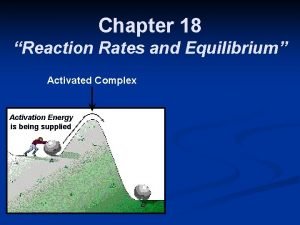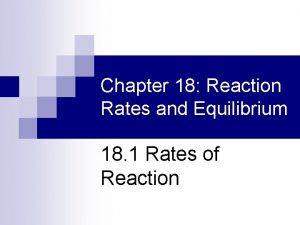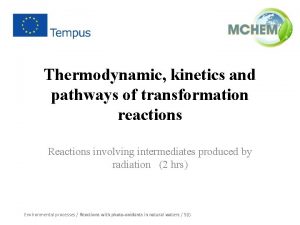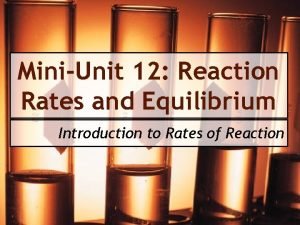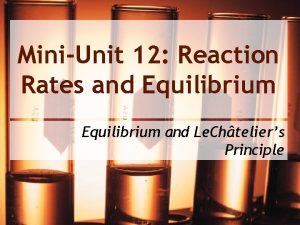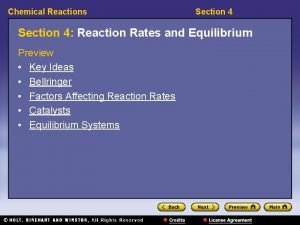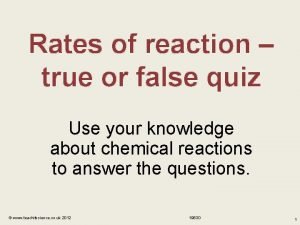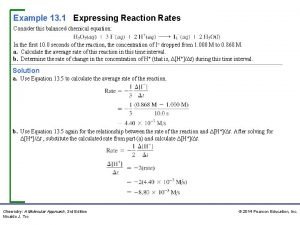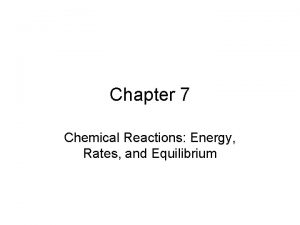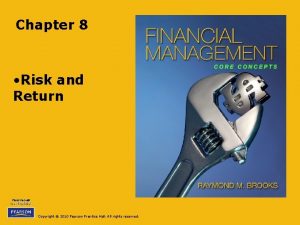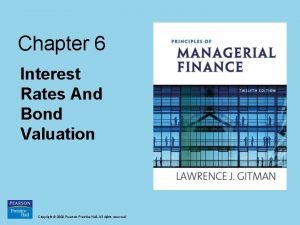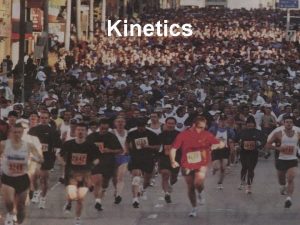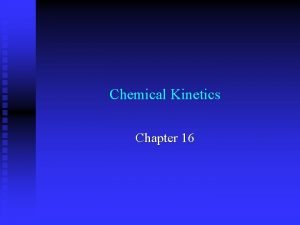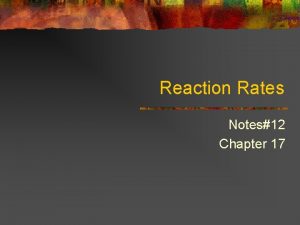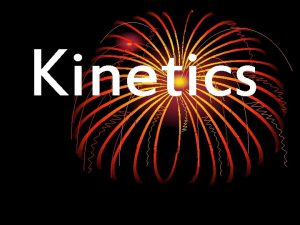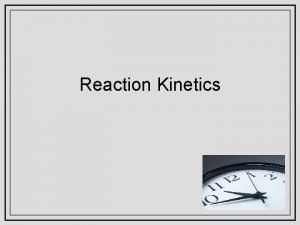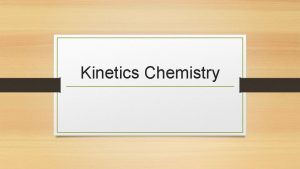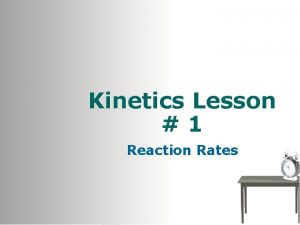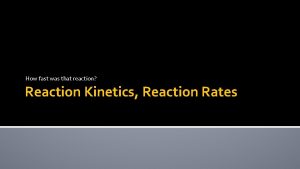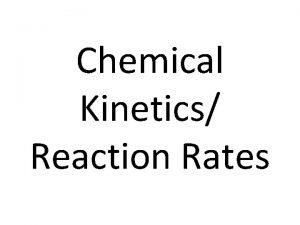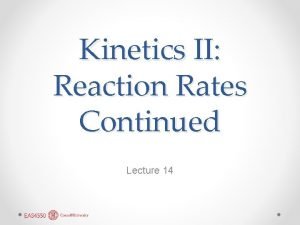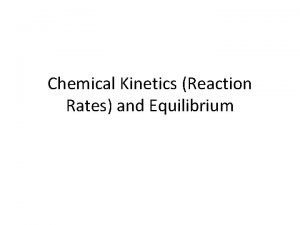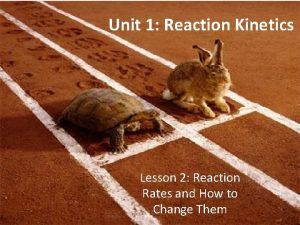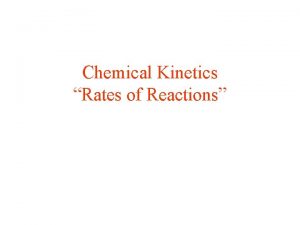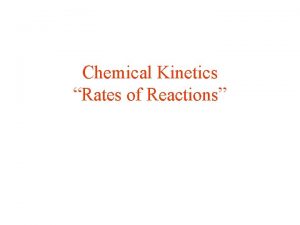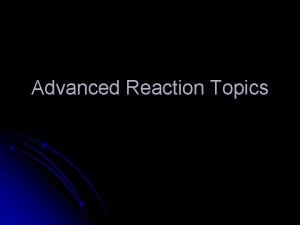Kinetics Chapter 12 Reaction Rates Kinetics is concerned
















![Calculating Activation Energy § Arrhenius Equation: k = [A]e-Ea/RT § Natural log of Arrhenius Calculating Activation Energy § Arrhenius Equation: k = [A]e-Ea/RT § Natural log of Arrhenius](https://slidetodoc.com/presentation_image_h2/36ca8485d92c17796be50f230192ee95/image-17.jpg)





- Slides: 22

Kinetics Chapter 12

Reaction Rates § Kinetics is concerned with studying the reaction mechanism of a reaction. § An average reaction rate describes how fast (not how spontaneous) a given reaction is overall. § Only positive rates are considered. In the event of a decrease in concentration, we insert a negative sign into the equation.

Reaction Rates on a Graph 2 NO 2 2 NO + O 2 § Graph concentration and time of reaction. § Slope of a line tangent to a point gives instantaneous rate.

Reaction Rate Summary § Average rate is not always equal to instantaneous rate. § Concentration of the products and reactants change over time, producing logarithmic curves. § Because concentration changes, rate is changing. § Coefficients in the balanced reaction indicate the relationship between the rates of reactions AND the concentrations.

Rate Laws Intro § All chemical reactions are reversible. § When the rate of the forward and reverse reactions are equal, it is called equilibrium. § Having the reverse reaction occur simultaneously with the forward messes with concentration. § We manipulate conditions to inhibit the progress of the reverse reaction when measuring rates.

Rate Law Equation § There are two types of rate laws. § Integrated § Regular Integrated Rate Law Compares concentration and time Rate = D[A]/Dt Regular Rate Law Compares concentration with rate of reaction Rate = k[A]n § Things to watch for: §How is the rate defined (in reference to which reactant). §Only reactants are included in rate law.

Determining the Order of Each Reactant in the Rate Law § The order is the superscript on the rate law. § These values are determined from data that is derived from several experiments that measure initial concentration and initial rate of reaction. § You must scrutinize the relationship between concentration and rate to determine the order of a given reactant. § Each reactant can have a different order.

Types of Orders § Zero Order § Change in concentration elicits no change in rate. § This will eliminate the reactant from the rate law. § First Order § Direct, equally proportional relationship between concentration and rate. § ½ the concentration, ½ the rate § 3 x the concentration, 3 x the rate, etc. § Second Order § Exponential relationship § ½ concentration, ¼ rate. § 3 x concentration, 9 x rate

Calculating orders Only compare one concentration variable at a time…look for reactions in which one variable is held constant.

Reaction Mechanisms § A reaction mechanism is a series of smaller reactions by which the overall reaction occurs. § The smaller reactions must add together to give the complete balanced overall reaction. § The experimentally derived rate law must agree with the rate law given in the slowest step of the reaction mechanism.

Types of elementary steps

Rate Determining Step § A reaction is only as fast as its slowest step. O 2 N NO 2 + NO 3 + + NO 3 O 2 + N O NO CO 2 C We have to hypothesize the slowest step based upon an experimentally known rate. NO 2 + CO NO + CO 2 has a rate law: Which is the rate determining step? Rate = k[NO 2]2

Try Me § The balanced equation for the reaction of gases nitrogen dioxide and fluorine is 2 NO 2(g) + F 2(g) 2 NO 2 F(g) The experimentally determined rate law is Rate = k[NO 2][F 2] A mechanism for this reaction is: NO 2 + F 2 NO 2 F + F F + NO 2 F Which part of the mechanism do you suppose is the most likely Rate Determining Step?

More Practice § A proposed mechanism for a reaction is slow fast C 4 H 9 Br C 4 H 9 + + Br C 4 H 9 + + H 2 O C 4 H 9 OH 2 + + H 2 O C 4 H 9 OH + H 3 O+ Write the rate law for this mechanism. What is the overall balanced equation for the reaction? What are the intermediates in the proposed mechanism?

Collision Theory and Kinetics § Molecules must collide to react. § Only some collisions a reaction. § Activation energy must be overcome to break and form necessary bonds. yield

Increase Productivity! § Temperature § Increase temperature, increase KE § # effective collisions = (total collisions)*e-Ea/RT § Molecular Orientation § What touches in a collision will determine if something happens or not.
![Calculating Activation Energy Arrhenius Equation k AeEaRT Natural log of Arrhenius Calculating Activation Energy § Arrhenius Equation: k = [A]e-Ea/RT § Natural log of Arrhenius](https://slidetodoc.com/presentation_image_h2/36ca8485d92c17796be50f230192ee95/image-17.jpg)
Calculating Activation Energy § Arrhenius Equation: k = [A]e-Ea/RT § Natural log of Arrhenius Equation: ln(k) = -(Ea/R)(1/T)+ ln[A]

Try Me!! § The Reaction: 2 N 2 O 5 4 NO 2 + O 2 yielded the following data. Calculate Ea. k (s-1) 2. 0 x 10 -5 7. 3 x 10 -5 2. 7 x 10 -4 9. 1 x 10 -4 2. 9 x 10 -3 T (o. C) 20 30 40 50 60

Derive This Equation: ln(k 2/k 1) = (Ea/R)(1/T 1 – 1//T 2) From These Equations: ln(k 1) = -(Ea/R)(1/T 1)+ ln(A) ln(k 2) = -(Ea/R)(1/T 2)+ ln(A)

Catalysis § Catalyst: a substance that speeds up a reaction without consumed during What do youbeing already know about the process. how a catalyst works? § How? § The presence of a catalyst causes the reaction to take a different reaction mechanism. § The new reaction mechanism has a different slow step. § The new slow step has a lower activation energy.


Heterogeneous Catalysts § Reactants are ADSORBED on the surface of the catalyst. § Reactants migrate on the surface of the catalyst. § Reactants form bonds and are desorbed from the surface of the catalyst. • Homogeneous catalysts exist in the same phase as the reactants…ie freon gas • Heterogeneous catalysts are in a phase…ie Pt metal
 Is a ratio a rate
Is a ratio a rate Equivalent ratios guided notes
Equivalent ratios guided notes Ratios rates and unit rates
Ratios rates and unit rates Ratios rates and unit rates
Ratios rates and unit rates Reaction rates and equilibrium worksheet answers chapter 19
Reaction rates and equilibrium worksheet answers chapter 19 Chapter 18 reaction rates and equilibrium
Chapter 18 reaction rates and equilibrium Chapter 18 reaction rates and equilibrium
Chapter 18 reaction rates and equilibrium Kinetics reaction
Kinetics reaction Mini unit reaction rates and equilibrium
Mini unit reaction rates and equilibrium Mini unit reaction rates and equilibrium
Mini unit reaction rates and equilibrium Section 4 reaction rates and equilibrium
Section 4 reaction rates and equilibrium Expressing reaction rates
Expressing reaction rates Rate of reaction quiz
Rate of reaction quiz Expressing reaction rates
Expressing reaction rates Reaction rates
Reaction rates Equation for rate of reaction
Equation for rate of reaction Addition reaction and substitution reaction
Addition reaction and substitution reaction Leukoerythroblastic reaction vs leukemoid reaction
Leukoerythroblastic reaction vs leukemoid reaction Half life formula
Half life formula Chapter 7 interest rates and bond valuation
Chapter 7 interest rates and bond valuation Chapter 8 risk and rates of return problem solutions
Chapter 8 risk and rates of return problem solutions Your uncle would like to restrict his interest rate risk
Your uncle would like to restrict his interest rate risk Chapter 6 interest rates and bond valuation
Chapter 6 interest rates and bond valuation





